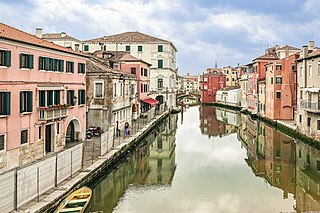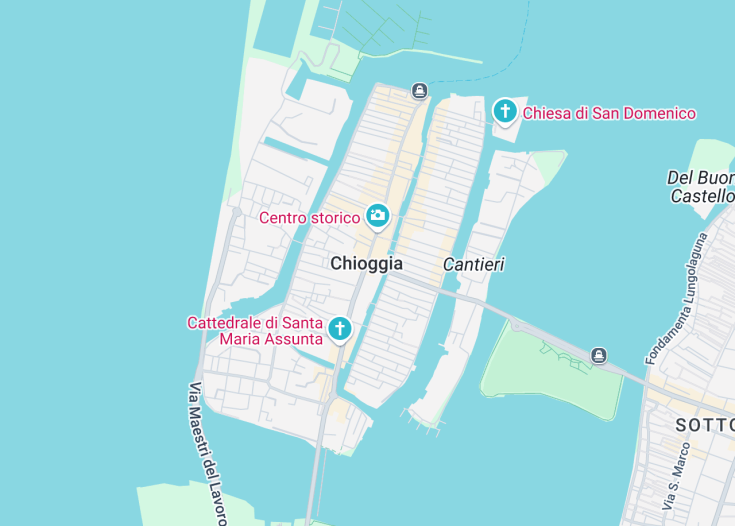Chioggia, often referred to as ‘Little Venice,’ is a charming fishing port nestled in the Veneto region of Italy. This picturesque town is distinguished by its canals, vibrant architecture, and centuries-old culture, mirroring the grandeur of nearby Venice but with a more tranquil, less tourist-trodden ambience. Chioggia offers a unique glimpse into authentic Italian maritime life, boasting historical sites like the Romanesque Cathedral of Chioggia and the bustling fish market, making it a captivating destination for culture enthusiasts and seafood lovers alike.
Consider visiting Chioggia during the ‘Sagra del Pesce’ festival in July, where you can experience the local culture through its seafood gastronomy and vibrant celebrations.
To fully appreciate Chioggia, take a leisurely stroll along the Canale Vena at dusk, where the colorful buildings and reflections on the water create a serene and picturesque scene.
Top things to do & see in Chioggia
Select the following sights and activities to discover best tickets and tours available in Chioggia.
Chioggia: A Serene Escape in Italy’s Northern Coast
| Country | Italy |
| Time in Chioggia | GMT+1 |
| Language spoken | Italian |
| Population | 50,000 (as of 2023, Italy’s National Institute of Statistics) |
| Currency | Euro (€, EUR) |
| Airports |
|
Located in Italy’s Veneto region, Chioggia is a picturesque town at the southern end of the Venice lagoon. Known as ‘Little Venice’, this charming locale offers a quieter, more relaxing alternative to its famous northern neighbor. Laden with history, it mirrors the canal-based urban structure of Venice along with distinctively colorful buildings and ancient churches. Chioggia’s fishing heritage shines through its vibrant seafood markets and local cuisine that encapsulates the flavors of the Adriatic Sea.
Its strategic coastal location has played a critical role historically, serving as a naval base and a center for trade and salt production, influencing its cultural and architectural development over the years. Today, Chioggia attracts visitors with its authentic Italian experience—from wandering in its narrow streets to enjoying relaxed boat rides on its calm waters, and visiting its bustling fish market, one of the largest in Italy.
The town’s Sagra del Pesce, or Fish Festival, held annually, celebrates this rich seafaring tradition with community feasts and regattas, making it a vibrant event that captivates both locals and tourists. The historical and cultural wealth of Chioggia is also encapsulated in various landmarks such as the Cathedral of Chioggia, with its neoclassical facade, and the Clock Tower, which provides panoramic views of the town and lagoon.
Environmental enthusiasts and bird watchers find the surrounding lagoon areas of Chioggia a haven for diverse species, contributing to its ecological importance. The synergy of history, culture, and nature makes Chioggia a compelling destination for those seeking an immersive Italian experience away from the typical tourist paths.
Where is Chioggia?
Chioggia is situated in the southern part of the Venice Lagoon, within the Veneto region of Italy.
Distances:
| Route | Distance by car | Time by car |
|---|---|---|
| Venice to Chioggia | 30 miles / 48 km | 50 minutes |
| Verona to Chioggia | 90 miles / 144 km | 1 hour 30 minutes |
| Padua to Chioggia | 25 miles / 40 km | 45 minutes |
What is Chioggia famous for?
Chioggia is celebrated for its Venice-like canal settings, rich fishing heritage showcased in the frequent fish markets, and vibrant annual events like the Sagra del Pesce, attracting culinary enthusiasts.
History
Pre-History to Roman Era
Chioggia’s history dates back to prehistoric times when it was likely inhabited by primitive peoples. The area began to gain prominence during the Roman era due to its strategic position in the Venetian Lagoon and its proximity to the Adriatic Sea. Archaeological findings suggest that early settlements were established for fishing and salt production, which were vital commodities during ancient times.
Medieval Period: 6th to 13th Century
With the decline of the Roman Empire, Chioggia, like many other Italian territories, felt the impact deeply. By the 6th century, it was evolving under the Byzantine Empire’s influence, becoming an essential military and commercial port. The town’s strategic importance was highlighted during the Middle Ages when it served as a critical point for trade and military operations against invaders. This period saw the fortification of Chioggia and its development as a thriving maritime hub within the Venetian Republic.
Renaissance to the Napoleonic Wars: 14th to 19th Century
During the Renaissance, Chioggia blossomed culturally and economically. The town’s shipbuilding industry surged, supporting Venice’s naval power. However, Chioggia’s history wasn’t without strife; the War of Chioggia (1379-1381) between Venice and Genoa showcased its military significance. This conflict eventually led to substantial rebuilding efforts in the following centuries. The Napoleonic Wars brought another period of turmoil when Chioggia fell under French control before becoming part of the Kingdom of Italy in the 19th century.
Modern Era: 20th Century to Present
Chioggia underwent significant changes in the 20th century, particularly during and after the World Wars. The town faced economic challenges but revitalized through tourism and the preservation of its historical heritage. Today, Chioggia is renowned not only for its historical and architectural treasures but also for being a vital fishing port and a gateway to the Venetian Lagoon, blending its ancient heritage with modern-day amenities.
Visit Chioggia
What to see and do in Chioggia, Italy
Chioggia, often referred to as ‘Little Venice’, is a testament to Italy’s rich cultural and maritime legacy. When arriving in Chioggia, visitors should start at the historical center where the vibrant life of this fishing town unfolds. The Corso del Popolo is lined with quaint shops and local eateries, perfect for enjoying the local cuisine.
- Explore the Cathedral of Santa Maria Assunta with its stunning artworks and the adjacent bell tower offering expansive views of the town and lagoon.
- Visit the Museum of the Southern Lagoon, which houses artifacts detailing the unique ecological and anthropological history of the lagoon.
- Take a leisurely boat tour around the lagoon to experience the serene environment and observe local wildlife.
- Experience the bustling fish market held daily, a tradition that harks back to the city’s roots as a fishing village.
Annual Festivals and Events in Chioggia
Chioggia hosts several cultural events and festivals throughout the year that celebrate its maritime history and vibrant local culture. Notable among these is the ‘Sagra del Pesce’, celebrated in June, which honors the town’s fishing heritage with a grand fish festival. Another significant event is the ‘Palio della Marciliana’, held in June, where locals dress in medieval costumes and recreate historical events reflecting Chioggia’s rich past.
Best time to visit Chioggia
The ideal time to visit Chioggia is during late spring and early summer, particularly from May to July. During this period, the weather is pleasantly warm, perfect for exploring the outdoor attractions and participating in local festivals. Additionally, the culinary offerings, especially seafood, are at their best, giving visitors a gourmet experience coupled with cultural immersion.
Is Chioggia worth visiting?
Indeed, Chioggia is a destination worth visiting for those who cherish historical depth, cultural richness, and unique culinary experiences. Its picturesque canals, vibrant markets, and the blend of historical and modern offerings provide a lesser-known yet equally enchanting counterpart to its neighbor, Venice. Whether you are a history enthusiast, a nature lover, or a gastronome, Chioggia offers a plethora of experiences that are sure to enrich any itinerary.










